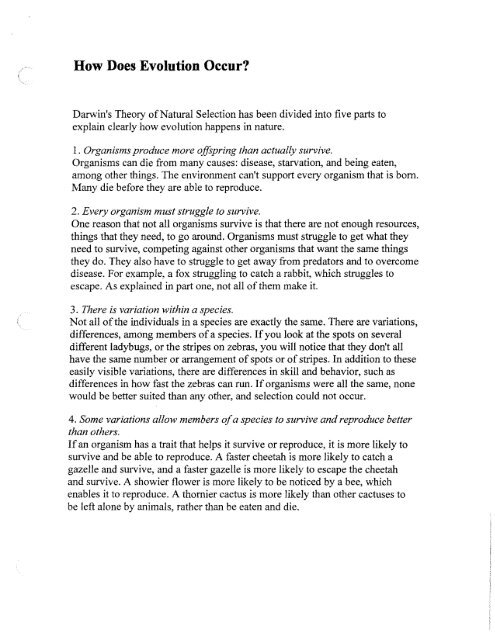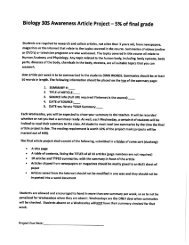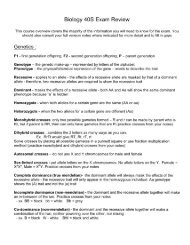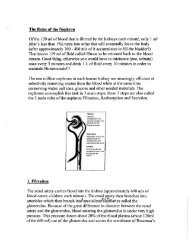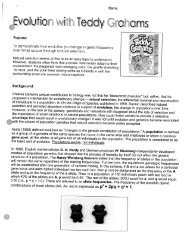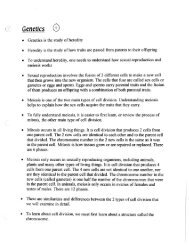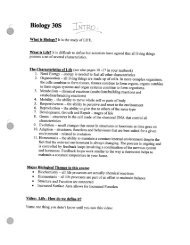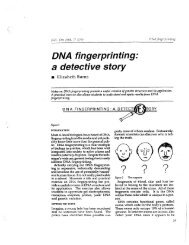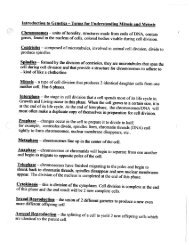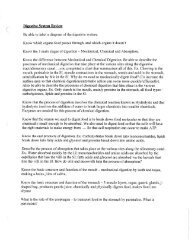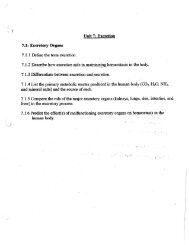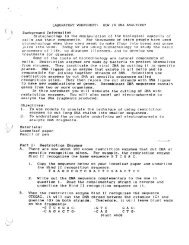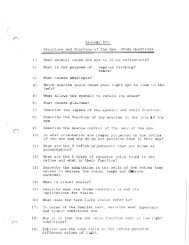How does Evolution Occur.pdf - Mrs Stovel
How does Evolution Occur.pdf - Mrs Stovel
How does Evolution Occur.pdf - Mrs Stovel
Create successful ePaper yourself
Turn your PDF publications into a flip-book with our unique Google optimized e-Paper software.
<strong>How</strong> Does <strong>Evolution</strong> <strong>Occur</strong>?<br />
Darwin's Theory of Natural Selection has been divided into five parts to<br />
explain clearly how evolution happens in nature.<br />
1. Organisms produce more offspring than actually survive.<br />
Organisms can die from many causes: disease, starvation, and being eaten,<br />
among other things. The environment can't support every organism that is born.<br />
Many die before they are able to reproduce.<br />
2. Every organism must struggle to survive.<br />
One reason that not all organisms survive is that there are not enough resources,<br />
things that they need, to go around. Organisms must struggle to get what they<br />
need to survive, competing against other organisms that want the same things<br />
they do. They also have to struggle to get away from predators and to overcome<br />
disease. For example, a fox struggling to catch a rabbit, which struggles to<br />
escape. As explained in part one, not all of them make it.<br />
3. There is variation within a species.<br />
Not all of the individuals in a species are exactly the same. There are variations,<br />
differences, among members of a species. If you look at the spots on several<br />
different ladybugs, or the stripes on zebras, you will notice that they don't all<br />
have the same number or arrangement of spots or of stripes. In addition to these<br />
easily visible variations, there are differences in skill and behavior, such as<br />
differences in how fast the zebras can run. If organisms were all the same, none<br />
would be better suited than any other, and selection could not occur.<br />
4. Some variations allow members of a species to survive and reproduce better<br />
than others.<br />
If an organism has a trait that helps it survive or reproduce, it is more likely to<br />
survive and be able to reproduce. A faster cheetah is more likely to catch a<br />
gazelle and survive, and a faster gazelle is more likely to escape the cheetah<br />
and survive. A showier flower is more likely to be noticed by a bee, which<br />
enables it to reproduce. A thornier cactus is more likely than other cactuses to<br />
be left alone by animals, rather than be eaten and die.
5. Organisms that survive and reproduce pass their traits to their offspring, and<br />
the helpful traits gradually appear in more and more of the population.<br />
Most of an organism's traits are passed on to its offspring. If more of the<br />
organisms with the helpful trait survive, then in the following generations,<br />
more and more of the population have that trait. If there are some faster<br />
cheetahs and some slower cheetahs, the faster cheetahs will be better able to<br />
catch food and survive. With more of the slower ones dying before they can<br />
reproduce, and more of the faster ones surviving and reproducing, over<br />
generations the population on the whole will gradually become made up of<br />
faster cheetahs.<br />
Here is an example demonstrating each of these points, told as the story of a<br />
population of brown hares in a polar region becoming white hares:<br />
1. There are hares living in a cold, snowy, polar region. All of the hares are<br />
brown* and many of them are killed and eaten by other animals each year, so<br />
more are born than survive.<br />
2. These hares are competing for life and struggling to survive, partly by trying<br />
to avoid predators, to "not be the one who gets eaten."<br />
3. Each hare is a little bit different from other hares, but one time a few hares<br />
are born albino, white, because of a mutation in the genes.<br />
4. This variation in color helps the albino hares to survive. Against the white<br />
snow, predators have a harder time seeing them, so more of the albino hares are<br />
able to survive and therefore to reproduce.<br />
5. In the next generation there are more white hares, because the white hair<br />
gene is passed on. In this generation, too, more white hares survive and<br />
reproduce. They pass the albino trait on to their offspring, who also survive and<br />
reproduce more than do the brown hares. Gradually, there are more and more<br />
white hares in the population, until the entire population is made of white hares.<br />
* You might ask: What were brown hares doing in a polar region? The brown<br />
color in an Arctic region was caused by one of two things, both of which are<br />
major causes of change and the arising of new species. One possibility was that<br />
a group of hares migrated from a warmer region and became isolated, the other<br />
is that the region where the hares lived became colder.
Lamarck vs. Darwin<br />
Jean-Baptiste Lamarck (1744-1829) and Charles Darwin (1809-1882) both thought and<br />
had ideas about how life on earth got to be the way it is now. They had some similar and<br />
some very different ideas.<br />
<strong>How</strong> They Agreed<br />
Unlike most other people at that time, Darwin and Lamarck both thought that life had<br />
changed gradually over time and was still changing, that living things change to be<br />
better suited and adapted to their environments, and that all organisms are related.<br />
Darwin and Lamarck also agreed that life evolved from fewer, simpler organisms to<br />
many, more complex organisms.<br />
What Lamarck Believed<br />
Lamarck is best known for his Theory oflnheritance ofAcquired Characteristics, first<br />
presented in 1801 (Darwin 's first book dealing with natural selection was published in<br />
1859): If an organism changes during life in order to adapt to its environment, those<br />
changes are passed on to its offspring. He said that change is made by what the<br />
organisms want or need. For example, Lamarck believed that elephants all used to have<br />
short trunks. When there was no food or water that they could reach with their short<br />
trunks, they stretched their trunks to reach the water and branches, and their offspring<br />
inherited long trunks. Lamarck also said that body parts that are not being used, such as<br />
the human appendix and little toes are gradually disappearing. Eventually, people will be<br />
born without these parts. Lamarck also believed that evolution happens according to a<br />
predetermined plan and that the results have already been decided.<br />
What Darwin Believed<br />
Darwin believed that the desires of animals have nothing to do with how they evolve,<br />
and that changes in an organism during its life do not affect the evolution of the species.<br />
He said that organisms, even of the same species, are all different and that those which<br />
happen to have variations that help them to survive in their environments, get to<br />
reproduce and have more offspring. The offspring are born with their parents` helpful<br />
traits, and as they reproduce, individuals with that trait make up more of the population.<br />
Other individuals, that are not so well adapted, die off For ex., elephants used to have<br />
short trunks, but some had longer trunks. When there was no food or water that they<br />
could reach with their short trunks, the ones with short trunks died off, and the ones with<br />
long trunks survived and reproduced. Eventually, all of the elephants had long trunks.<br />
Darwin also believed that evolution <strong>does</strong> not happen according to any sort of plan.
Change and Isolation<br />
Environmental change and isolation of groups of organisms play an important<br />
role in evolution.<br />
Environmental change is any change in an environment to which an organism<br />
must adapt. Change can be gradual, such as when mountains or deserts form,<br />
other species die out, or new species evolve. These things can take millions of<br />
years, Change to an environment can also be quick, such as floods, volcanoes,<br />
or earthquakes. It can also be caused not by change to the environment itself,<br />
but by the organism's movement to a different environment.<br />
Change in an organism's environment forces the organism to adapt to fit the<br />
new environment, eventually causing it to evolve into a new species. For<br />
example, if a species of animal is mostly limited to eating one kind of leaf, and<br />
a change occurs: a fungus attacks and kills most of that kind of plant, the<br />
animal has to evolve either to fight the fungus or to eat something else.<br />
Isolation means that organisms of the same species are separated, and happens<br />
when there is something between the organisms that they can't cross.<br />
Organisms become isolated as a result of environmental change. The cause of<br />
isolation can be gradual, like when mountains or deserts form, or continents<br />
split apart. It can also be quick, such as organisms being blown to different<br />
places by a storm or tsunami (tidal waves).<br />
When organisms become isolated the two groups are also not able to reproduce<br />
together, so variations and mutations that occur in one group are not necessarily<br />
found in the other group. The longer the groups are isolated, the more different<br />
they are. They eventually become different species. Moreover, if there is a<br />
change in the environment of one group it <strong>does</strong> not necessarily occur in the<br />
environment of the other. So they will evolve and adapt differently.<br />
The finches and other organisms that Darwin found on the Galapagos Islands<br />
are examples that demonstrate the effect that environmental change and<br />
isolation can have on a species.
Sexual Selection<br />
Up until now, we have discussed reproduction of an organism as resulting<br />
from traits that enable it to survive. For example, in a cold climate, lots of fur<br />
enables survival, which enables reproduction (which leads to these traits being<br />
passed on and becoming more common). This can be called "reproduction<br />
through survival." The ability to reproduce, however, also results from traits<br />
that are directly related to the ability to reproduce, but play no role in the<br />
survival of the individual organism. This is "reproduction through<br />
reproduction."<br />
In evolution, having traits that help one survive is very important, but it is only<br />
important so that one can reproduce and pass those traits to the next generation.<br />
For this reason, traits that enable an organism to reproduce, without necessarily<br />
helping them to survive are selected for: the ones that reproduce pass the traits<br />
that helped them to reproduce on to their offspring and the ones that don't<br />
reproduce don't have offspring, so their traits disappear from the population.<br />
Darwin called this idea "sexual selection".<br />
Here are two examples:<br />
The male peacock has a lot of showy feathers. One would think that these<br />
would not appear in evolution; they would be noticeable to predators and would<br />
get the peacock stuck so it would not be able to escape from predators or get<br />
food. <strong>How</strong>ever, peacocks use their feathers to attract peahens (female<br />
peacocks). The peacocks with the showier feathers are able to attract mates, so<br />
they are the ones that have offspring, and pass on the fancy-feather genes to the<br />
next generation. <strong>How</strong>ever, the organism must also be able to survive. Peacocks<br />
can fold up their tails, which lessens the danger of being noticed by predators<br />
or getting caught in the bushes. In addition, as with most species where the<br />
males are colorful or fancy to attract the females, the peahens are much duller<br />
and more camouflaged, in a large part because they are the ones who guard the<br />
eggs and chicks. Survival of the next generation is very important.<br />
Many plants have flowers that are pretty and brightly colored. This is because<br />
the brightest colors attract bees, butterflies, and other pollinators, which enable<br />
the plant to reproduce. If a flower is dully colored, it <strong>does</strong> not reproduce, and<br />
the dull color genes dissappear from the population, whereas the plants with<br />
brightly colored flowers reproduce, so they gradually make up more and more<br />
of the population.
Co-<strong>Evolution</strong><br />
One of the most important parts of an organism's environment is other organisms. Coevolution<br />
occurs when, in adapting to their environments, two or more organisms evolve<br />
together. To "make the best of' where they live, organisms make use of other organisms<br />
by eating them, living on or in them, and/or building a "partnership" with them.<br />
Organisms co-evolve with many species at the same time, because an environment<br />
includes many different types of organisms.<br />
Organisms have to adapt to form these relationships just as they have to adapt to any<br />
other part of their environments. These adaptations cause so much change that<br />
descendants, who are better suited to take advantage of the relationship, are so different<br />
that they may be an entirely different species than their ancestors.<br />
It is important to note that species that are closely related did not always appear at the<br />
same time. For example, although the first mammals appeared approximately 225<br />
million to 180 million years ago, not all mammal species appeared at that time. This is<br />
especially important to realize in the case of co-evolution. Organisms have co-evolved<br />
whose families first appeared very far apart on evolution's time scale. For example, the<br />
first segmented flatworms originated millions of years before the first mammals.<br />
<strong>How</strong>ever, the tapeworm, a segmented flatworm that is a parasite of humans, cows, and<br />
other mammals, could not have evolved before the first large mammals, because it<br />
adapted so much to the parasitic relationship that its ancestors before the relationship<br />
were not of the same species of worm.<br />
Three types of co-evolution are predator-prey relationships, symbiotic relationships, and<br />
parasitic relationships.


